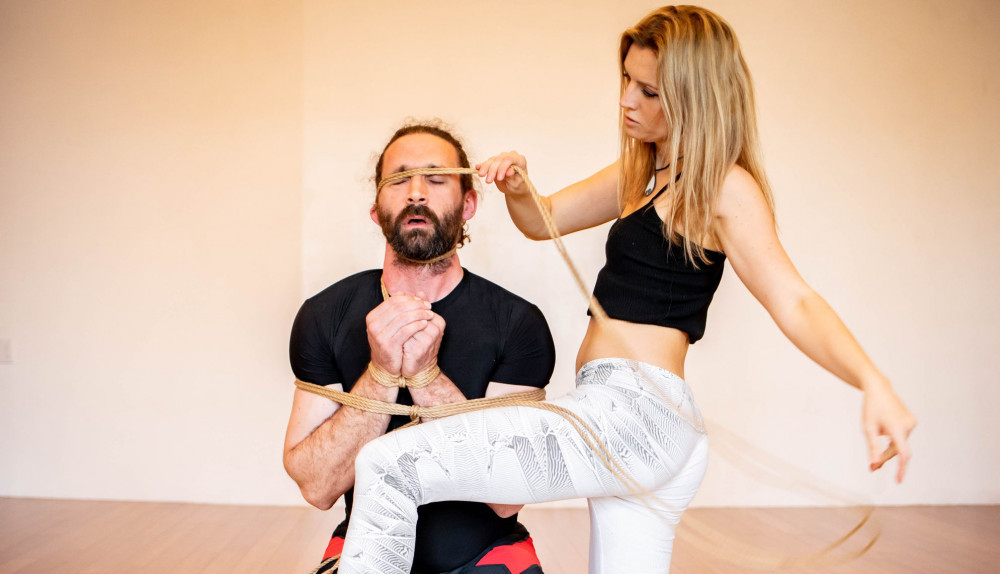Those interested in bondage may have heard of Shibari, known as Japanese bondage. Discover what makes Shibari unique – and if it might be for you.
The Origin of Shibari in Ancient Japan
The Japanese bondage style Shibari has developed from the practiced tying technique of Hojōjutsu. Where the term Hojōjutsu means exactly that: tying technique.
Hojōjutsu had been used mainly in the military and police field since the Japanese Middle Ages, especially in the transportation or transfer of prisoners. Hojōjutsu also served as a deterrent, for example, to exhibit the tied-up individuals as a warning example. From this practice, Shibari eventually developed into a form of bondage in modern Japan.
Shibari and Bondage, where are the differences?
Shibari primarily pursues an aesthetic, not a sexual goal. Through the manner of tying and the knots, an artwork is to be created. This is presented already in its creation or finished. The presentation of the tied-up person is the focus of Shibari, in contrast to Bondage. Certain body parts or areas are emphasized and staged for this purpose.
The often-practiced Bondage with the aim of restraining someone for the purpose of pleasure or restricting freedom of movement is only partially reflected in Shibari. Nevertheless, this art of tying can, as is usual in Bondage, prepare for further sadomasochistic practices. It is important that in Shibari, the public display of the tied-up person is an integral part of it.


Shibari Rope, Rigger, and Rope-Bunny
In Shibari, you can find the traditional roles of Bondage. The so-called Rigger is the person who ties the other. The Rope-Bunny is the person who allows themselves to be tied up. Since Shibari is an art form, the Rope-Bunny is also often referred to as a model, as in photo shoots. This is also because the term Rope-Bunny sounds derogatory to some.
The Rigger uses traditional Shibari rope for the Japanese bondage of their model. Originally, the Shibari rope was made of hemp, jute, or cotton. Nowadays, there are also synthetic versions available. Since Japanese bondage often involves the entire body and not just the hands or feet, it is important to pay attention to the correct length of the Shibari rope.
Special Techniques of Japanese Bondage
As numerous as the Shibari techniques are, so rich in tradition is this form of tying. Shibari ranges from simple hand tie-ups to highly complex full-body restraints. The goal: to bring out and showcase the beauty of the mostly female body. Making the model or Rope-Bunny actually immobile can also play a role. So, Shibari is both: a simple knot or the completion of the completely tied-up, immobile, and exposed body.
From the origin of Hojōjutsu to Shibari, there are numerous subtypes. Such as hanging bondage (Tsurizeme) or net-like full-body bindings or rope dresses (Karada).
If the tied-up area is particularly designed for the vulva, it is called Sakurambo (the cherry) or Matanawa (the crotch tie). It is also possible to focus particularly on the breasts. Then, colloquially, especially in the USA, Shinju is spoken of. The term coined in the USA has nothing to do with the Japanese Shinjü: This refers to the planned suicide of two people in love.
What is Bondage in General?
Bondage is a popular practice within the BDSM scene. The tie-ups aim to restrict movement or even take it away completely. The term Bondage comes from English and means something like bondage or servitude. Compared to Shibari, there is a narrower focus on sexual stimulation and usually a stronger emphasis on reactive interaction.
Further intentions of Bondage can also be the public display of the tied-up person, the sexual act, or the intensification of sensation through concentration.


As is well known, the B in BDSM stands for Bondage (Bondage & Discipline, Dominance & Submission, and Sadism & Masochism). Whether artfully according to ancient tradition or simply fastened on the whipping bench: tying up plays an important role in BDSM.
For many Bondage fans, the art of tying and thus the helplessness of the Rope-Bunny already make up the main part of the pleasure. As is common in the BDSM area, the tying up should consciously abolish equality between the people involved. For the duration of the session, the Rope-Bunny relinquishes control and completely surrenders through the applied art of tying. Nevertheless, it is important to ensure that the pre-defined boundaries are not exceeded. For example, by agreeing on a safe word.
Dangers in Japanese Bondage and Shibari
In Shibari, as in any form of tying, there are dangers and risks. It is impossible to exclude these. Through accumulated experience, intensive practice, and constant communication, risks can be minimized.
The most common sources of danger include pressure damage and overstimulation of the nerves. Nerve pathways run through the entire body. For a safe and pleasurable Shibari experience, solid basic knowledge is therefore a prerequisite, as even short-term impairments can develop into serious damage. Compressed or overstimulated nerve pathways can lead to numbness in the tied-up person, but a reaction of the nerve pathways is not always immediately noticeable.
If complications occur after a session, caution should be exercised to prevent permanent damage. In case of doubt, it is advisable to contact medical professionals.
Tying up or compressing veins and arteries can also lead to serious health problems. One danger is promoting thrombosis by stagnating blood flow. Likewise, bruising of veins and arteries can damage nerves.
Since Shibari is a form of tying that partially involves the entire body, oxygen supply can be impaired. In particular, the ties around the neck (carotid artery) and chest area should be checked.
In dangerous situations, it is important to remain calm and take the necessary first aid measures. As with all forms of bondage and BDSM, agreeing on a safe word is essential. Respecting the boundaries of the respective counterpart and ensuring that nothing happens without consent applies in all contexts – even beyond the sexual.
Many tying moments in Shibari, dear Kinksters, Bondage, and Shibari friends.
JOYclub: What is that?


- With over 5 million members, JOYclub is a lively, sex-positive community that will turn your love life completely upside down.
- Whether you're male, female, trans, single or a couple, JOYclub is the place to discover and live out your erotic fantasies with other members (with your partner, if you like).
- Curious? Then register for free and without obligation and discover the fascinating JOYclub world. We are looking forward to meeting you!




